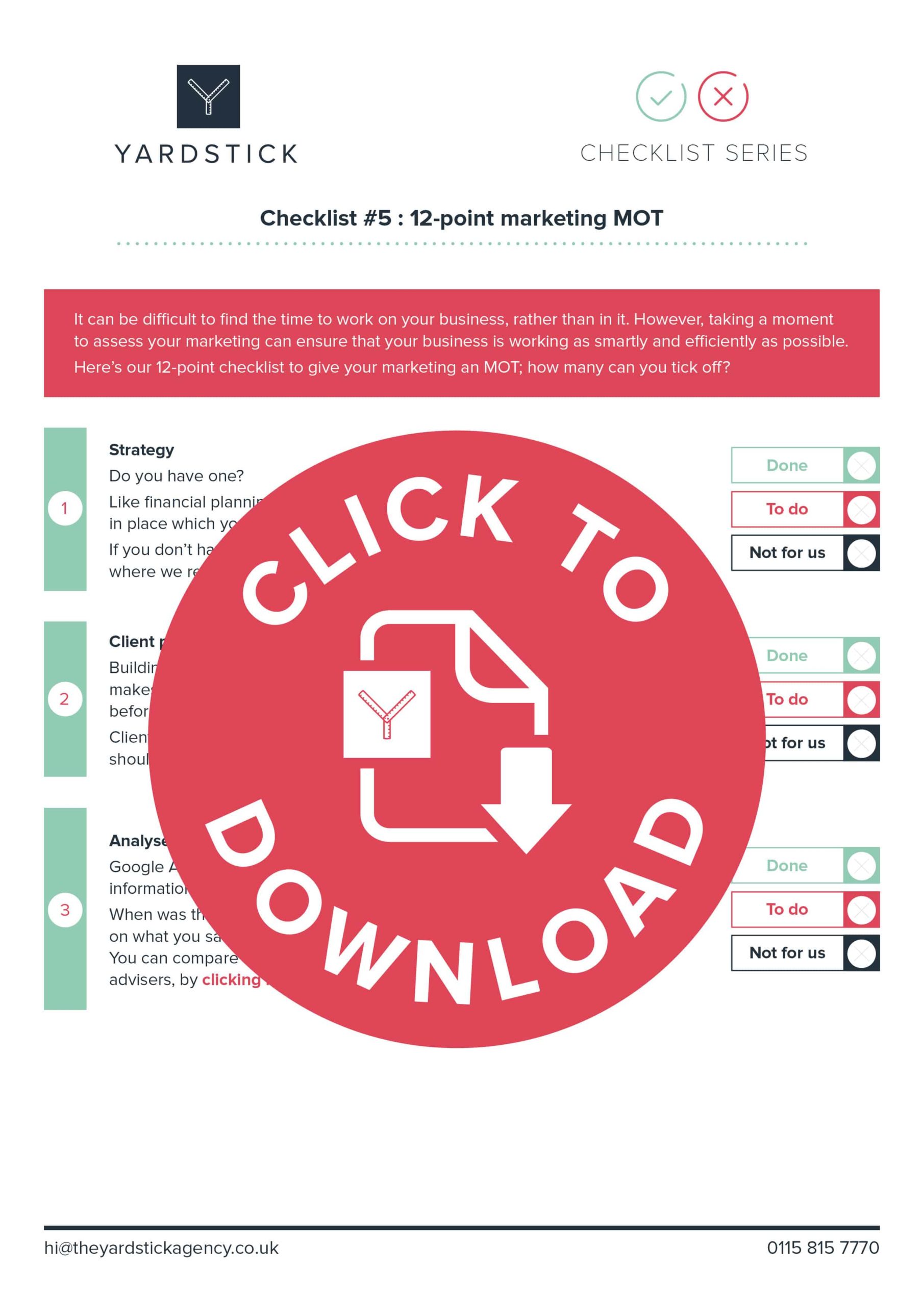 If you’re a business owner, there are times when you need to work on your business, and not in it.
If you’re a business owner, there are times when you need to work on your business, and not in it.
Business development is something that can easily fly under your radar, particularly if you’re busy with clients. However, it’s important that you don’t neglect the wider aspects of running your company.
To help you, we’ve put together a 12-point checklist to give your marketing an MOT. So, print it off, grab a cup of tea, and see how many of these jobs you can tick off.
1. Marketing strategy
Do you have one?
Like financial planning, marketing works best when you have a strategy in place which you can implement effectively.
If you don’t have a marketing strategy this, in tandem with item two, is where we recommend you start.
2. Client personas
Building client personas is a key investment we recommend everyone makes before they start to build a marketing strategy. We’d certainly suggest it before you begin building websites, using social media, and so on.
Client personas will help you understand your target audience, what you should be saying to them and how you should be saying it.
3. Analyse your website’s performance
Google Analytics is a free tool which provides a huge amount of valuable information about your website and how it’s performing.
When was the last time you checked your Analytics and took action based on what you saw?
You can compare the performance of your website with that of other advisers by clicking here and using our Adviser Index.
4. Review your website’s homepage
![]() Google Analytics will confirm this, but your homepage is likely to be the most popular page on your website. Making sure it’s as effective as possible is therefore crucial.
Google Analytics will confirm this, but your homepage is likely to be the most popular page on your website. Making sure it’s as effective as possible is therefore crucial.
How is yours performing? Bounce rate too high? Time on page too low? Review yours and make changes as necessary to improve it.
Our checklist will help you make your homepage more effective.
5. Client testimonials and reviews
![]() Testimonials and reviews, ideally attributable to the clients who kindly gave them to you, are hugely important additions to your website and marketing literature. They provide the proof that you are as good as you say you are and that your clients truly benefit from the advice you’ve given.
Testimonials and reviews, ideally attributable to the clients who kindly gave them to you, are hugely important additions to your website and marketing literature. They provide the proof that you are as good as you say you are and that your clients truly benefit from the advice you’ve given.
However, too many advisers collect testimonials once, usually when their website is built, They have no ongoing process for collecting them.
We recommend putting in a process for collecting feedback from new clients, while asking existing clients for their feedback. We recommend asking for testimonials by email – our template will help you do this.
6. Do you use case studies?
Case studies are a great way of showing how you work, the value of advice and how you improve the lives of your clients.
Ideally, case studies should include real client circumstances (there’s no need to give details of their financial affairs) along with their names, and preferably a photo. For the ‘wow’ factor case study, videos are the holy grail.
7. How mobile compatible is your website?
Our research shows that an increasing percentage of traffic to adviser websites is coming via mobile and tablet devices.
We also know that Google includes mobile compatibility (and speed) of your site in its search algorithm.
You can check the mobile compatibility of your site by using this tool from Google.
8. Are you promoting your Chartered status effectively?
![]() Whether it is you, or your firm, being Chartered will set you apart from other advisers and planners – but only if you promote it effectively.
Whether it is you, or your firm, being Chartered will set you apart from other advisers and planners – but only if you promote it effectively.
This means prominently displaying the accreditation on your literature. This particularly applies to your website. Don’t hide the logo in the footer next to your regulatory statement. Bring it above the fold and explain what it means, why it makes you different and how it benefits your clients.
Our checklist will help you promote your Chartered status more effectively.
9. Are you disclosing fees effectively online?
We believe each firm should decide for themselves whether or not to disclose their fees online. That’s a decision only you can make.
However, if you decide it’s the right thing to do, it must be done in a way which won’t deter your website visitors from getting in touch. That means putting your fees in context, showing the services you deliver in return, and demonstrating the value of advice.
10. Are you communicating with your clients effectively?
Content is hugely important for generating new enquiries.
However, before you rush out and start writing, filming or recording, you need to understand how your target audience prefers to receive content. That’s why client personas are so important.
Once you know that, and what’s relevant to your clients, you can start to produce content.
11. Are your directory listings as effective as they could be?
![]() Our marketing research shows that advisers and planners can expect to accept two or three enquiries per month from Unbiased.
Our marketing research shows that advisers and planners can expect to accept two or three enquiries per month from Unbiased.
If you aren’t accepting that many, or are unhappy in some way with how your directory listing (that’s principally Unbiased and VouchedFor) is working for you, now’s the time to review it.
Our checklist will help you.
12. Could you be doing more with social media?
Our research shows that advisers get less than 10% of their website traffic from social media. That represents a massive opportunity for advisers who truly engage online.
Go back to your client personas, understand which social media channels your target audience use and consider how you can use those channels to engage with more people.
We hope you found this useful
How did you do? Was it a pass? Or have you flagged a few things you need to review?
If you’ve made it this far, you’ll likely have plenty to go off and work on. If you’d like more information about any of our 12 points, or any advice or help, you can reach us by emailing hi@theyardstickagency.co.uk or calling 0115 815 7770.


